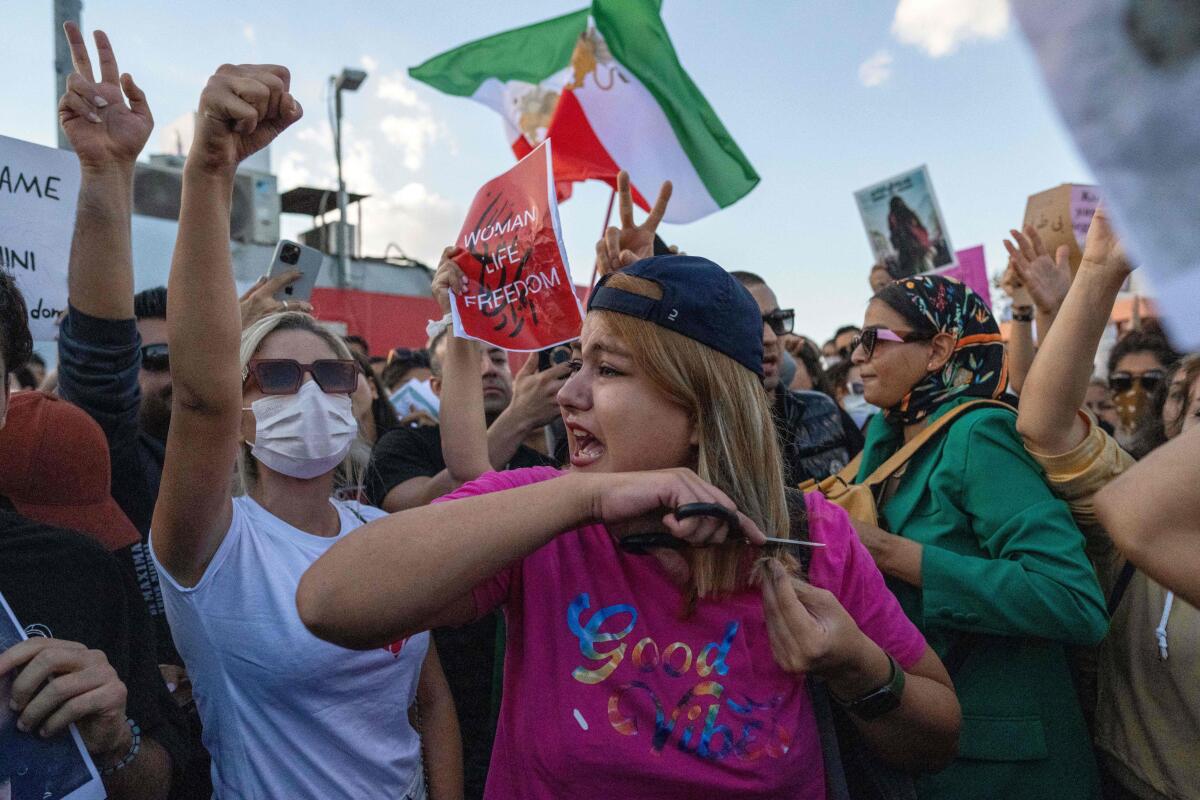U.S. hits Iran with new sanctions as punishment for ‘brutal’ crackdown on protesters

- Share via
WASHINGTON — With efforts to revive the Iran nuclear deal languishing, the Biden administration on Wednesday hit Tehran with a new batch of economic sanctions as punishment for repression of widespread demonstrations against restrictions on women and other issues.
Iranian security forces have cracked down on thousands of citizens protesting the death in police custody last month of Mahsa Amini, a young Iranian Kurdish woman who was arrested for supposedly wearing her hijab incorrectly. The protests have broadened to air additional grievances over political and civil rights, forming one of the largest protest movements in the Islamic Republic in years.
Scores of protesters have been reported killed.
The Biden administration blacklisted 14 Iranian officials, including intelligence officials, prison wardens and a governor, and three entities or companies, including a network of hackers it accused of interfering with protesters’ ability to communicate, organize and gain access to social media.
The sanctions aim to hold accountable Iranian officials responsible for the brutal crackdown on protesters, abuse inside Iran’s notorious prisons, censorship and “malicious cyberactivity against the Iranian people,” U.S. Secretary of State Antony J. Blinken said.
The U.S. “will continue to impose costs on individuals and entities in Iran who engage in the brutal repression of the Iranian people,” Blinken added.
The measures prohibit those targeted from doing business with people, firms and many banking institutions in the U.S. and usually from traveling to this country. They are among scores of sanctions already in place that have helped cripple the Iranian economy but done little to stop what the U.S. refers to as Tehran’s malicious activities, including support for armed militants in the region.
In recent days, U.S. officials added to the list of misdeeds the accusation that Iran is supplying Russia with armed drones being used to attack civilians and critical infrastructure in Ukraine. The U.S. also says it has intelligence that Iranian military personnel are training Russians, within Russian-occupied parts of Ukraine, on how to use the drones.
Moscow and Tehran have denied the claim, contradicting photographs the Ukrainian military has supplied of downed drones.
“There is clear, unmistakable evidence of Iran’s support to various malign actors, from the Houthis [in Yemen] to Russia to others in conflict zones around the world, of UAV [drone] technology,” State Department spokesman Ned Price said, citing a recent closed-door session of the United Nations Security Council. UAV stands for “unmanned aerial vehicle.”
Israel also said it was providing the U.S. with evidence of Iran’s drones attacking Ukraine. Israeli President Isaac Herzog, in Washington to meet with President Biden on Wednesday, said intelligence had identified some of the downed drones as those displayed publicly by Iran in recent years.
Iran “is a threat to regional and global stability,” Herzog told reporters ahead of the meeting at the White House.
Israel is also the world’s most vocal opponent to the Iran nuclear deal, a landmark international accord signed in 2015 that limited Tehran’s ability to produce nuclear material. Then President Trump pulled out of the agreement in 2018, saying it wasn’t tough enough, and it all but collapsed.
Iran resumed its enrichment of uranium, raising fears it could get closer to having the ability to build a bomb.
The Biden administration embarked on arduous indirect negotiations with European signatories to the deal, serving as mediator with Iran in hopes of reviving it. But the talks, held in Vienna, bogged down at an apparent impasse, and it is unclear what the future of the accord is.
These latest developments — the crackdown on protesters and Russia’s reported use of Iranian drones in Ukraine — only further complicate reaching a deal, over which there is strong opposition in some parts of the U.S. Congress.
Amini was arrested on Sept. 13 by Iran’s so-called morality police for supposedly failing to wear her head cover tightly enough. She died in police custody three days later. The police said the 22-year-old collapsed and died of natural causes. Her family says she had been beaten.
“Forty days after the tragic death of Mahsa Amini, Iranians continue to bravely protest in the face of brutal suppression and disruption of internet access,” Brian Nelson, undersecretary of the Treasury for financial intelligence, said in a statement.
The new sanctions “on Iranian officials overseeing organizations involved in violent crackdowns and killings, including of children, [are] part of our commitment to hold all levels of the Iranian government accountable for its repression,” he said.
The 40-day mark after a death receives special observance in several religions, including Shiite Islam, and supporters of Amini filled the streets of her Kurdish hometown and flocked to her gravesite, while demonstrations erupted again in Tehran and other cities.
Separately, the U.S. also imposed yet another round of sanctions on Russia, this time for its alleged interference in elections in nearby Moldova and efforts to control most branches of the former Soviet republic’s government and “subvert Moldovan democracy.” The sanctions named several oligarchs who form an important part of Russian President Vladimir Putin’s power base.
More to Read
Get the L.A. Times Politics newsletter
Deeply reported insights into legislation, politics and policy from Sacramento, Washington and beyond. In your inbox twice per week.
You may occasionally receive promotional content from the Los Angeles Times.











